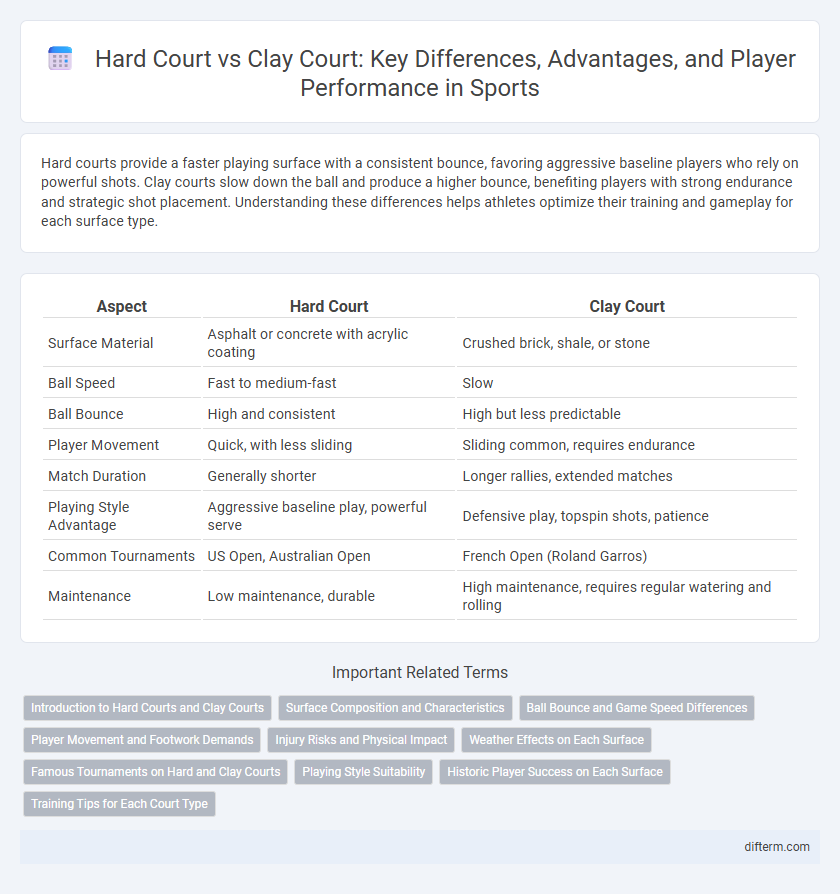Hard courts provide a faster playing surface with a consistent bounce, favoring aggressive baseline players who rely on powerful shots. Clay courts slow down the ball and produce a higher bounce, benefiting players with strong endurance and strategic shot placement. Understanding these differences helps athletes optimize their training and gameplay for each surface type.
Table of Comparison
| Aspect | Hard Court | Clay Court |
|---|---|---|
| Surface Material | Asphalt or concrete with acrylic coating | Crushed brick, shale, or stone |
| Ball Speed | Fast to medium-fast | Slow |
| Ball Bounce | High and consistent | High but less predictable |
| Player Movement | Quick, with less sliding | Sliding common, requires endurance |
| Match Duration | Generally shorter | Longer rallies, extended matches |
| Playing Style Advantage | Aggressive baseline play, powerful serve | Defensive play, topspin shots, patience |
| Common Tournaments | US Open, Australian Open | French Open (Roland Garros) |
| Maintenance | Low maintenance, durable | High maintenance, requires regular watering and rolling |
Introduction to Hard Courts and Clay Courts
Hard courts provide a fast-paced playing surface with consistent ball bounce, typically made from asphalt or concrete topped with an acrylic layer. Clay courts, made from crushed shale, stone, or brick, offer a slower surface that produces higher ball bounce and longer rallies, favoring baseline players with strong endurance. Both surfaces significantly influence player strategy and footwork, shaping the dynamics of professional tennis matches.
Surface Composition and Characteristics
Hard courts consist of rigid materials like asphalt or concrete topped with acrylic layers, providing consistent ball bounce and faster play speeds suitable for aggressive baseline players. Clay courts, made from crushed shale, stone, or brick, create a softer surface that slows ball speed and produces higher bounce, favoring extended rallies and strategic point construction. The surface composition directly influences player endurance, stroke technique, and match dynamics, making court selection a critical factor in competitive tennis.
Ball Bounce and Game Speed Differences
Hard courts produce a higher and more consistent ball bounce compared to clay courts, which often result in slower and more variable bounce patterns. The faster surface of hard courts accelerates game speed, favoring aggressive baseline play, while clay courts slow down ball velocity, promoting longer rallies and strategic point construction. These differences significantly impact player performance and match dynamics, influencing tactics and physical demands.
Player Movement and Footwork Demands
Hard courts demand quick, explosive movements with more frequent stops and starts, requiring players to have strong ankle stability and rapid foot adjustments. Clay courts slow down the ball, promoting longer rallies and sliding footwork, which challenges players to maintain balance and endurance over extended points. Mastering diverse footwork techniques on both surfaces is essential for optimal performance and injury prevention.
Injury Risks and Physical Impact
Hard courts generate higher impact forces on joints due to their rigid surface, increasing the risk of stress fractures and joint injuries like tendinitis. Clay courts offer better shock absorption and sliding ability, reducing joint stress but increasing the risk of muscle strains and ligament sprains from abrupt movements. Athletes experience distinct physical demands on each surface, with hard courts stressing bones and joints, while clay courts challenge muscular endurance and flexibility.
Weather Effects on Each Surface
Hard courts dry quickly under direct sunlight, allowing consistent bounce and faster gameplay even after rain. Clay courts retain moisture longer due to their porous nature, resulting in slower ball speed and higher bounce when damp. Temperature fluctuations affect hard courts with surface expansion and contraction, while clay courts become compact or loose, significantly influencing player movement and match duration.
Famous Tournaments on Hard and Clay Courts
The US Open and Australian Open are premier hard court tournaments known for their fast-paced gameplay and high-intensity matches. Roland Garros, also called the French Open, is the most prestigious clay court event, challenging players with slower surfaces and longer rallies. Hard courts favor powerful serves and quick points, while clay courts emphasize endurance and strategic play.
Playing Style Suitability
Hard courts provide a consistent bounce and faster surface speed, favoring aggressive baseline players who excel with powerful serves and flat groundstrokes. Clay courts slow down the ball and produce a higher bounce, benefiting players with strong endurance, strategic point construction, and effective topspin shots. Preferences in playing style often determine a player's success on either surface, with serve-and-volley tactics thriving on hard courts and patience-based, defensive skills flourishing on clay.
Historic Player Success on Each Surface
Historic player success reveals that Rafael Nadal dominates clay courts with a record 14 French Open titles, illustrating his exceptional prowess on slower surfaces. Conversely, hard courts have favored players like Novak Djokovic and Serena Williams, who have amassed numerous Grand Slam titles at the US Open and Australian Open, showcasing their adaptability and strong baseline play. The contrasting speed and bounce of hard versus clay courts have shaped distinct playing styles, influencing which players excel on each surface.
Training Tips for Each Court Type
Training on hard courts requires players to focus on developing speed and agility due to the faster ball bounce and lower friction, emphasizing quick footwork and explosive movements. Practicing on clay courts should prioritize endurance and sliding techniques, as the slower surface demands strategic point construction and patience. Strengthening leg muscles and improving stamina are essential for success on clay, while hard court training benefits from drills that enhance reaction time and power.
hard court vs clay court Infographic

 difterm.com
difterm.com